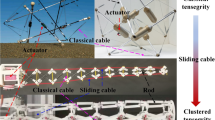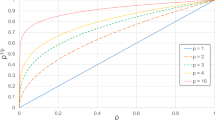Abstract
An eight-node solid-beam element based on absolute nodal coordinate formulation (ANCF) which uses cubic interpolation at the longitudinal direction and linear at the transverse direction is proposed. The element can accurately discretize the geometry represented by the Bézier volume with the same basis function order. The continuity property of the proposed beam element is verified. Advantages of the proposed element can be found in the application of leaf spring modeling. The parabolically varying thickness of the leaf can be accurately described. Components in leaf spring such as the spring eye and the rubber bushing can be assembled efficiently since the proposed element can be connected at any direction. The ANCF reference node is used to represent the rigid components and the revolute joints in the vehicle suspension system. Static I-shaped cross-section cantilever beam and flexible pendulum model are used to test the accuracy and dynamic performance of the proposed solid-beam element. The leaf spring model shows the flexibility of the element in modeling the complex mechanical system and the balance between the accuracy and the efficiency.
Graphic abstract
An eight-node ANCF solid-beam element is proposed. The element can accurately discretize the geometry represented by the Bézier volume with the same basis function order. The parabolically varying thickness of the leaf can be accurately described. Components in leaf spring such as the spring eye and the rubber bushing can be assembled efficiently since the proposed element can be connected at any direction. Numerical results show that the proposed element can reach good balance between the accuracy and the efficiency.
















Similar content being viewed by others
References
Hughes, T.J.R., Cottrell, J.A., Bazilevs, Y.: Isogeometric analysis: CAD, finite elements, NURBS, exact geometry and mesh refinement. Comput. Methods Appl. Mech. Eng. 194, 4135–4195 (2005). https://doi.org/10.1016/j.cma.2004.10.008
Lan, P., Shabana, A.A.: Integration of B-spline geometry and ANCF finite element analysis. Nonlinear Dyn. 61, 193–206 (2009). https://doi.org/10.1007/s11071-009-9641-6
Piegl, L., Tiller, W.: The NURBS book. Springer, New York (1997)
Sanborn, G.G., Shabana, A.A.: A rational finite element method based on the absolute nodal coordinate formulation. Nonlinear Dyn. 58, 565–572 (2009). https://doi.org/10.1007/s11071-009-9501-4
Lan, P., Shabana, A.A.: Rational finite elements and flexible body dynamics. J. Vib. Acoust. 10(1115/1), 4000970 (2010)
Yamashita, H., Sugiyama, H.: Numerical convergence of finite element solutions of nonrational B-spline element and absolute nodal coordinate formulation. Nonlinear Dyn. 67, 177–189 (2011). https://doi.org/10.1007/s11071-011-9970-0
Zhao, Y., Ma, C., Wei, C., et al.: Modeling and verification of a RANCF fluid element based on cubic rational bezier volume. J. Comput. Nonlinear Dyn. (2020). https://doi.org/10.1115/1.4046206
Ma, C., Wei, C., Sun, J., et al.: Modeling method and application of rational finite element based on absolute nodal coordinate formulation. Acta Mech. Solida Sin. 31, 207–228 (2018). https://doi.org/10.1007/s10338-018-0020-z
Shabana, A.A., Hamed, A.M., Mohamed, A.N.A., et al.: Use of B-spline in the finite element analysis: comparison with ANCF geometry. J. Comput. Nonlinear Dyn. (2012). https://doi.org/10.1115/1.4004377
Lan, P., Yu, Z., Du, L., et al.: Integration of non-uniform Rational B-splines geometry and rational absolute nodal coordinates formulation finite element analysis. Acta Mech. Solida Sin. 27, 486–495 (2014). https://doi.org/10.1016/s0894-9166(14)60057-4
Yu, Z., Lan, P., Lu, N.: A piecewise beam element based on absolute nodal coordinate formulation. Nonlinear Dyn. 77, 1–15 (2014). https://doi.org/10.1007/s11071-014-1248-x
Nada, A.A.: Use of B-spline surface to model large-deformation continuum plates: procedure and applications. Nonlinear Dyn. 72, 243–263 (2013). https://doi.org/10.1007/s11071-012-0709-3
Mikkola, A., Shabana, A.A., Sanchez-Rebollo, C., et al.: Comparison between ANCF and B-spline surfaces. Multibody Syst. Dyn. 30, 119–138 (2013). https://doi.org/10.1007/s11044-013-9353-z
Yu, Z., Shabana, A.A.: Mixed-coordinate ANCF rectangular plate finite element. J. Comput. Nonlinear Dyn. (2015). https://doi.org/10.1115/1.4028085
Frischkorn, J., Reese, S.: A solid-beam finite element and non-linear constitutive modelling. Comput. Methods Appl. Mech. Eng. 265, 195–212 (2013). https://doi.org/10.1016/j.cma.2013.06.009
Kerkkänen, K.S., Sopanen, J.T., Mikkola, A.M.: A linear beam finite element based on the absolute nodal coordinate formulation. J. Mech. Des. (2005). https://doi.org/10.1115/1.1897406
Li, P., Gantoi, F.M., Shabana, A.A.: Higher order representation of the beam cross section deformation in large displacement finite element analysis. J. Sound Vib. 330, 6495–6508 (2011). https://doi.org/10.1016/j.jsv.2011.07.013
Pan, K.Q., Liu, J.Y.: Geometric nonlinear dynamic analysis of curved beams using curved beam element. Acta Mech. Sin. 27, 1023–1033 (2011). https://doi.org/10.1007/s10409-011-0509-x
Dufva, K.E., Sopanen, J.T., Mikkola, A.M.: A two-dimensional shear deformable beam element based on the absolute nodal coordinate formulation. J. Sound Vib. 280, 719–738 (2005). https://doi.org/10.1016/j.jsv.2003.12.044
Shabana, A.A., Yakoub, R.Y.: Three dimensional absolute nodal coordinate formulation for beam elements: theory. J. Mech. Des. (2001). https://doi.org/10.1115/1.1410100
Yakoub, R.Y., Shabana, A.A.: Three dimensional absolute nodal coordinate formulation for beam elements: implementation and applications. J. Mech. Des. (2001). https://doi.org/10.1115/1.1410099
Sugiyama, H., Gerstmayr, J., Shabana, A.A.: Deformation modes in the finite element absolute nodal coordinate formulation. J. Sound Vib. 298, 1129–1149 (2006). https://doi.org/10.1016/j.jsv.2006.06.037
Patel, M., Shabana, A.A.: Locking alleviation in the large displacement analysis of beam elements: the strain split method. Acta Mech. 229, 2923–2946 (2018). https://doi.org/10.1007/s00707-018-2131-5
Nachbagauer, K.: State of the art of ANCF elements regarding geometric description, interpolation strategies, definition of elastic forces, validation and the locking phenomenon in comparison with proposed beam finite elements. Arch. Comput. Methods Eng. 21, 293–319 (2014). https://doi.org/10.1007/s11831-014-9117-9
Sugiyama, H., Suda, Y.: A curved beam element in the analysis of flexible multi-body systems using the absolute nodal coordinates. Proc. Inst. Mech. Eng. K 221, 219–231 (2007). https://doi.org/10.1243/1464419jmbd86
Shen, Z., Li, P., Liu, C., et al.: A finite element beam model including cross-section distortion in the absolute nodal coordinate formulation. Nonlinear Dyn. 77, 1019–1033 (2014). https://doi.org/10.1007/s11071-014-1360-y
Zhao, C.H., Bao, K.W., Tao, Y.L.: Transversally higher-order interpolating polynomials for the two-dimensional shear deformable ANCF beam elements based on common coefficients. Multibody Syst. Dyn. (2020). https://doi.org/10.1007/s11044-020-09768-4
Xu, Q., Liu, J., Qu, L.: Dynamic modeling for silicone beams using higher-order ANCF beam elements and experiment investigation. Multibody Syst. Dyn. 46, 307–328 (2019). https://doi.org/10.1007/s11044-019-09668-2
Nachbagauer, K., Pechstein, A.S., Irschik, H., et al.: A new locking-free formulation for planar, shear deformable, linear and quadratic beam finite elements based on the absolute nodal coordinate formulation. Multibody Syst. Dyn. 26, 245–263 (2011). https://doi.org/10.1007/s11044-011-9249-8
Nachbagauer, K., Gruber, P., Gerstmayr, J.: Structural and continuum mechanics approaches for a 3D shear deformable ANCF beam finite element: application to static and linearized dynamic examples. J. Comput. Nonlinear Dyn. (2012). https://doi.org/10.1115/1.4006787
Nachbagauer, K., Gerstmayr, J.: Structural and continuum mechanics approaches for a 3D shear deformable ANCF beam finite element: application to buckling and nonlinear dynamic examples. J. Comput. Nonlinear Dyn. (2013). https://doi.org/10.1115/1.4025282
García-Vallejo, D., Mikkola, A.M., Escalona, J.L.: A new locking-free shear deformable finite element based on absolute nodal coordinates. Nonlinear Dyn. 50, 249–264 (2007). https://doi.org/10.1007/s11071-006-9155-4
Xu, Q., Liu, J.: An improved dynamic model for a silicone material beam with large deformation. Acta Mech. Sin. 34, 744–753 (2018). https://doi.org/10.1007/s10409-018-0759-y
Lan, P., Tian, Q., Yu, Z.: A new absolute nodal coordinate formulation beam element with multilayer circular cross section. Acta Mech. Sin. 36, 82–96 (2019). https://doi.org/10.1007/s10409-019-00897-4
Orzechowski, G., Shabana, A.A.: Analysis of warping deformation modes using higher order ANCF beam element. J. Sound Vib. 363, 428–445 (2016). https://doi.org/10.1016/j.jsv.2015.10.013
Zhang, Y., Wei, C., Zhao, Y., et al.: Adaptive ANCF method and its application in planar flexible cables. Acta Mech. Sin. 34, 199–213 (2017). https://doi.org/10.1007/s10409-017-0721-4
Wang, Q.T., Tian, Q., Hu, H.Y.: Contact dynamics of elasto-plastic thin beams simulated via absolute nodal coordinate formulation. Acta Mech. Sin. 32, 525–534 (2015). https://doi.org/10.1007/s10409-015-0533-3
Shabana, A.A., Xu, L.: Rotation-based finite elements: reference-configuration geometry and motion description. Acta Mech. Sin. 37, 105–126 (2021). https://doi.org/10.1007/s10409-020-01030-6
Zhang, J., Lu, J., Han, W., et al.: Program load spectrum compilation for accelerated life test of parabolic leaf spring. Int. J. Automot. Technol. 20, 337–347 (2019). https://doi.org/10.1007/s12239-019-0033-8
Zhao, L., Zhang, Y., Yu, Y., et al.: Truck handling stability simulation and comparison of taper-leaf and multi-leaf spring suspensions with the same vertical stiffness. Appl. Sci. 10(4), 1293 (2020). https://doi.org/10.3390/app10041293
Yu, Z., Liu, Y., Tinsley, B., et al.: Integration of geometry and analysis for vehicle system applications: continuum-based leaf spring and tire assembly. J. Comput. Nonlinear Dyn. (2015). https://doi.org/10.1115/1.4031151
Omar, M.A., Shabana, A.A., Mikkola, A., et al.: Multibody system modeling of leaf springs. Modal Anal. 10, 1601–1638 (2016). https://doi.org/10.1177/1077546304042047
Sugiyama, H., Shabana, A.A., Omar, M.A., et al.: Development of nonlinear elastic leaf spring model for multibody vehicle systems. Comput. Methods Appl. Mech. Eng. 195, 6925–6941 (2006). https://doi.org/10.1016/j.cma.2005.02.032
Atig, A., Ben Sghaier, R., Seddik, R., et al.: A simple analytical bending stress model of parabolic leaf spring. Proc. Inst. Mech. Eng. C J. Mech. Eng. Sci. 232, 1838–1850 (2018). https://doi.org/10.1177/0954406217709302
Atig, A., Ben Sghaier, R., Seddik, R., et al.: Reliability-based high cycle fatigue design approach of parabolic leaf spring. Proc. Inst. Mech. Eng. L 233, 588–602 (2019). https://doi.org/10.1177/1464420716680499
Kumar, P., Matawale, C.R.: Analysis and optimization of mono parabolic leaf spring material using ANSYS. Mater. Today 33, 5757–5764 (2020). https://doi.org/10.1016/j.matpr.2020.06.605
Wang, T., Tinsley, B., Patel, M.D., et al.: Nonlinear dynamic analysis of parabolic leaf springs using ANCF geometry and data acquisition. Nonlinear Dyn. 93, 2487–2515 (2018). https://doi.org/10.1007/s11071-018-4338-3
Shabana, A.A.: Computer implementation of the absolute nodal coordinate formulation for flexible multibody dynamics. Nonlinear Dyn. 16, 293–306 (1998). https://doi.org/10.1023/a:1008072517368
García-Vallejo, D., Mayo, J., Escalona, J.L., et al.: Efficient evaluation of the elastic forces and the Jacobian in the absolute nodal coordinate formulation. Nonlinear Dyn. 35, 313–329 (2004). https://doi.org/10.1023/b:Nody.0000027747.41604.20
Shabana, A.A.: ANCF reference node for multibody system analysis. Proc. Inst. Mech. Eng. K 229, 109–112 (2014). https://doi.org/10.1177/1464419314546342
Shabana, A.A.: ANCF tire assembly model for multibody system applications. J. Comput. Nonlinear Dyn. (2015). https://doi.org/10.1115/1.4028479
Pappalardo, C.M., Yu, Z., Zhang, X., et al.: Rational ANCF thin plate finite element. J. Comput. Nonlinear Dyn. (2016). https://doi.org/10.1115/1.4032385
Lan, P., Cui, Y., Yu, Z.: A novel absolute nodal coordinate formulation thin plate tire model with fractional derivative viscosity and surface integral-based contact algorithm. Proc. Inst. Mech. Eng. K 233, 583–597 (2018). https://doi.org/10.1177/1464419318816527
Tian, Q., Lou, J., Mikkola, A.: A new elastohydrodynamic lubricated spherical joint model for rigid-flexible multibody dynamics. Mech. Mach. Theory 107, 210–228 (2017). https://doi.org/10.1016/j.mechmachtheory.2016.09.006
Wang, Q., Tian, Q., Hu, H.: Dynamic simulation of frictional multi-zone contacts of thin beams. Nonlinear Dyn. 83, 1919–1937 (2015). https://doi.org/10.1007/s11071-015-2456-8
Acknowledgements
This research was supported by the National Natural Science Foundation of China (Grant No. 11802072) and Key Project of Science and Technology of Hu’nan Province (Grant No. 2018GK1040).
Author information
Authors and Affiliations
Corresponding author
Additional information
Executive Editor: Qiang Tian.
Rights and permissions
About this article
Cite this article
Yu, Z., Cui, Y. New ANCF solid-beam element: relationship with Bézier volume and application on leaf spring modeling. Acta Mech. Sin. 37, 1318–1330 (2021). https://doi.org/10.1007/s10409-021-01089-9
Received:
Revised:
Accepted:
Published:
Issue Date:
DOI: https://doi.org/10.1007/s10409-021-01089-9




